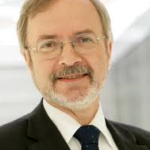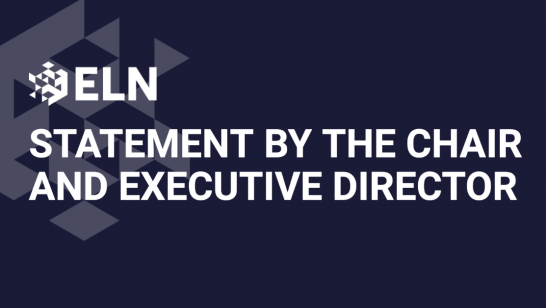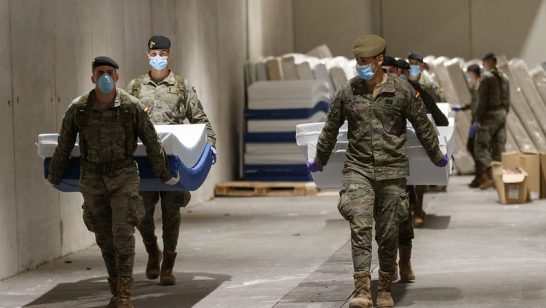
This is the text of a speech delivered by Minister of State Werner Hoyer, German Ministry of Foreign Affairs, at an ELN Dinner in Berlin.
Sehr geehrter Herr Bundespräsident, Lord Browne of Ladyton, Ambassador Dhanapala, Sehr geehrter Herr Professor Bahr, Excellencies, Colleagues, Ladies and Gentlemen.
Our dinner tonight gives me the possibility to personally welcome you, the participants and guests of the first ELN Symposium on German soil, right in the heart of the once divided Berlin close to Potsdamer Platz.
“Reducing the Role of Nuclear Weapons in the NATO-Russia Relationship” is the title of your conference here in the Foreign Office. Our joint political goal – further reductions in nuclear arms – can only come about by using the cooperative instrument of fostering dialogue and mutual confidence.
Where else if not here in the formerly divided city of Berlin can one better appreciate the concrete and positive contributions of a cooperative disarmament approach resulting in a European continent finally free from dividing lines and most conflicts? We should therefore continue to draw the right conclusions from such a successful cooperative approach as a guiding principle.
Today, I see many Russian friends sitting close to their German, British, and French colleagues. Twenty years after the end of the Cold War this is only natural, I assume.
However, I have to state the obvious: We are still searching for solutions for a number of important current security policy challenges.
For the Federal Government arms control and disarmament have always been central elements of our foreign and security policy agenda. Through its elements of transparency and verification, arms control can serve the purpose of building trust and reassurance, especially in an ever more global and interconnected world. Trust, I believe, is the major political currency in a world of permanent change.
2010 was a good year for arms control. Let me just briefly mention the consensus reached at the NPT Review Conference after 10 years of deadlock, the signing of New START and the adoption of NATO’s new strategic concept.
Nevertheless, we cannot rest on our laurels. We have to focus now on the open issues. Concrete problems in the NATO-Russia relationship cannot be argued away. It is therefore important to clearly indicate what the problems are, and to try and find adequate solutions.
Hence, I would like to focus on three concrete aspects – or problems, if you like – in the context of the overall NATO-Russian security relationship:
- nuclear weapons reductions,
- invigorating conventional arms control and
- how to establish a missile defense system that NATO and Russia can both benefit from.
Ladies and Gentlemen,
Let me begin with the good news. At the 2010 Lisbon Summit NATO committed itself to work towards creating the necessary conditions for a world without nuclear weapons for the first time. For us, this is not only a positive signal. It is a substantial success!
Germany for its part has consistently advocated the inclusion of non-strategic nuclear weapons in the nuclear disarmament process. This is because we believe that the European continent would greatly benefit from further reducing its nuclear arsenals. And we have taken the lead in putting this issue on the agenda of NATO. Believe me, this was not an easy task!
The German policy on this issue is bolstered by a clear mandate, given by the Government’s coalition agreement: working towards withdrawal of the remaining US nuclear weapons from Germany.
We see these weapons as left-overs from the Cold War, and we do not believe that they serve any military purpose any longer.
We raised this issue in the broader context of a changing security environment to which the Alliance has to respond. From the outset, we have made it clear that we do not intend to move unilaterally, but that we want to build a consensus within the Alliance.
The new Strategic Concept adopted at the Lisbon summit expressed NATO’s readiness to create the conditions for further reductions of nuclear weapons stationed in Europe. At the same time it also pointed at the need to address the disparity with the much greater Russian stockpile.
Unfortunately, in the last months official Russian voices have made it quite clear that Moscow is not very interested in discussing the topic of its sub-strategic nuclear arsenal.
This rejection should not prevent us from discussing concrete proposals, at least for initiating a possible future reduction process.
One idea could be to revive the so-called US-Russian Presidential Initiatives of 1991/92. Since those days, non-strategic weapons have not been the object of arms control efforts. We are aware that addressing them in a New START follow-on process will be a complex and challenging issue – both with regard to the political and the technical aspects.
As a starting point we could aim at improving transparency and confidence-building. Implementation of the 1991/92 commitments has never been subject to any accountability or verification, which adds an additional hurdle to re-engaging on these weapons. But this should not prevent us from getting started.
NATO’s new Strategic Concept endorsed the aim of seeking Russian agreement to increase transparency on their nuclear weapons. In line with this objective, we have taken the initiative, together with like-minded partners such as Poland and Norway, to start a dialogue on possible confidence-building and transparency measures in the NATO-Russia Council.
While only the US and Russia can conduct negotiations on the reduction of these weapons, such a dialogue to which we can all contribute could serve as an important facilitator.
The second point I would like to address is conventional disparities. Russia sees the issue of sub-strategic nuclear weapons in context with other pertinent questions such as co-operation on missile defense or conventional arms control. Indeed security in Europe is indivisible and requires a comprehensive approach. I agree on that.
But sometimes conventional disparities are being used as an excuse to reject the reduction of nuclear potentials. I would argue, if conventional disparities are a potential source of insecurity for Europe – we should address them. Luckily enough we have overcome the Cold War divide with its massive troop concentrations in Central Europe. Still, our continent would benefit from a modern and functioning conventional arms control regime.
Unfortunately, at the moment this is made much more difficult by the failure of the process in the Vienna talks “at 36”. The “cornerstone of European security”, the CFE Treaty, is severely affected by Russia’s decision to opt out of it. As a consequence we have to acknowledge that NATO and Russia are still in search for a common language addressing European security.
Let me be clear on this: the Federal Government firmly believes that conventional arms control and confidence and security building measures are not just an attachment to Europe’s security but are at the very heart of the debate about a common security space, incorporating the Russian Federation.
What can be done on this issue now? We need to find new approaches – also within the Alliance – on how to strengthen conventional arms control in Europe. We should seek to increase openness and verifiable transparency. The NATO-Russia Council could provide a platform to discuss conventional arms control issues. We should tap its full potential!
Ladies and Gentlemen,
Let me eventually come to the last big issue on our NATO-Russia agenda: Missile Defense (MD) – and many observers agree on that – could become the “game changer” in the overall NATO-Russia relationship. Nevertheless, some raise the caveat that it is far from being clear whether this enormous potential will be realized in the end.
The US has set the ground for a fresh start on MD by modifying their policy with the so-called European Phased Adaptive Approach. This re-adjustment includes a resolutely cooperative outreach with regard to NATO – and with regard to Russia.
We appreciate that both President Medvedev and President Obama are personally committed to making NATO-Russian MD cooperation a success. And it is also important that Secretary General Anders Fogh Rasmussen is personally committed to develop and strengthen NATO-Russia relations.
However, determining the parameters for NATO-Russian cooperation on MD is an extremely challenging task. Given its record as a major irritant in US-Russian relations, finding a common approach will necessitate not only the political will but also a genuine respect for each side’s sensitivities and of course a spirit of real compromise.
After having accepted NATO’s invitation to the NATO Lisbon Summit, President Medvedev, instantly seized the opportunity to present the Russian vision of a joint NATO-Russian MD architecture. This approach has become known as “sectoral approach”, which basically refers to different zones of responsibility to engage. So far, so good.
The problem is: Russia has underlined its “preparedness” to assume responsibility for a sector reaching beyond its own territory. Needless to say, that such an approach triggered immediate reservations on NATO’s side, especially from our eastern neighbors.
At the same time we should not reject outright Russian objections to what it calls a “Take-it-or-leave-it approach”. Although there is no such approach in NATO-Russia cooperation, I believe that this point must be taken seriously.
At the same time, NATO-Russian cooperation must not be used as an instrument or a pretext to determine NATO’s internal decision-making processes.
To avoid misperceptions and move on in a cooperative manner I would first of all suggest we seek agreement on the political principles and objectives of our MD cooperation. What we cannot afford is to draw absolute red lines.
In a second step we should work on effectively engaging all sides concerned in the process. Here, transparency and practical re-assurance can also serve as key elements. We should not wait to make some concrete steps towards MD cooperation. We could, for instance, explore options for joint MD elements, e. g. centers for sensoric data fusion or generic operations planning. We can also start preparing practical exercises. Testing NATO-Russia Missile Defense activities against the background of reality will be important in the development of our cooperation. Clearly, this is an area where Germany can make concrete contributions and will do so.
The search for a cooperative security concept between NATO and the Russian Federation probably dates back, at least until the 1967 Report by Pierre Harmel. Since then, arms control and confidence-building have been integral parts of NATO’s strategic posture.
The new Strategic Concept of NATO is in line with this healthy tradition.
It is now the right time to add substance to the political declarations. As I see it for now, NATO and Russia are in principle moving in the right direction, but potholes and possible dead ends remain along the road.
I am convinced that more transparency on sub-strategic nuclear weapons could become the appropriate catalyzer for future efforts to reduce these kinds of weapons. Conventional arms control – if based on transparency and verification – could add a critical trust-building component to this process. Last but not least, Missile Defense opens up the perspective of a truly common and cooperative security approach, if based on reciprocal understandings.
I believe that a balanced and cooperative security dialogue with Russia can create the right conditions for a truly common and indivisible security space – for both NATO and Russia!
The opinions articulated above represent the views of the author(s), and do not necessarily reflect the position of the European Leadership Network or any of its members. The ELN’s aim is to encourage debates that will help develop Europe’s capacity to address the pressing foreign, defence, and security challenges of our time.



